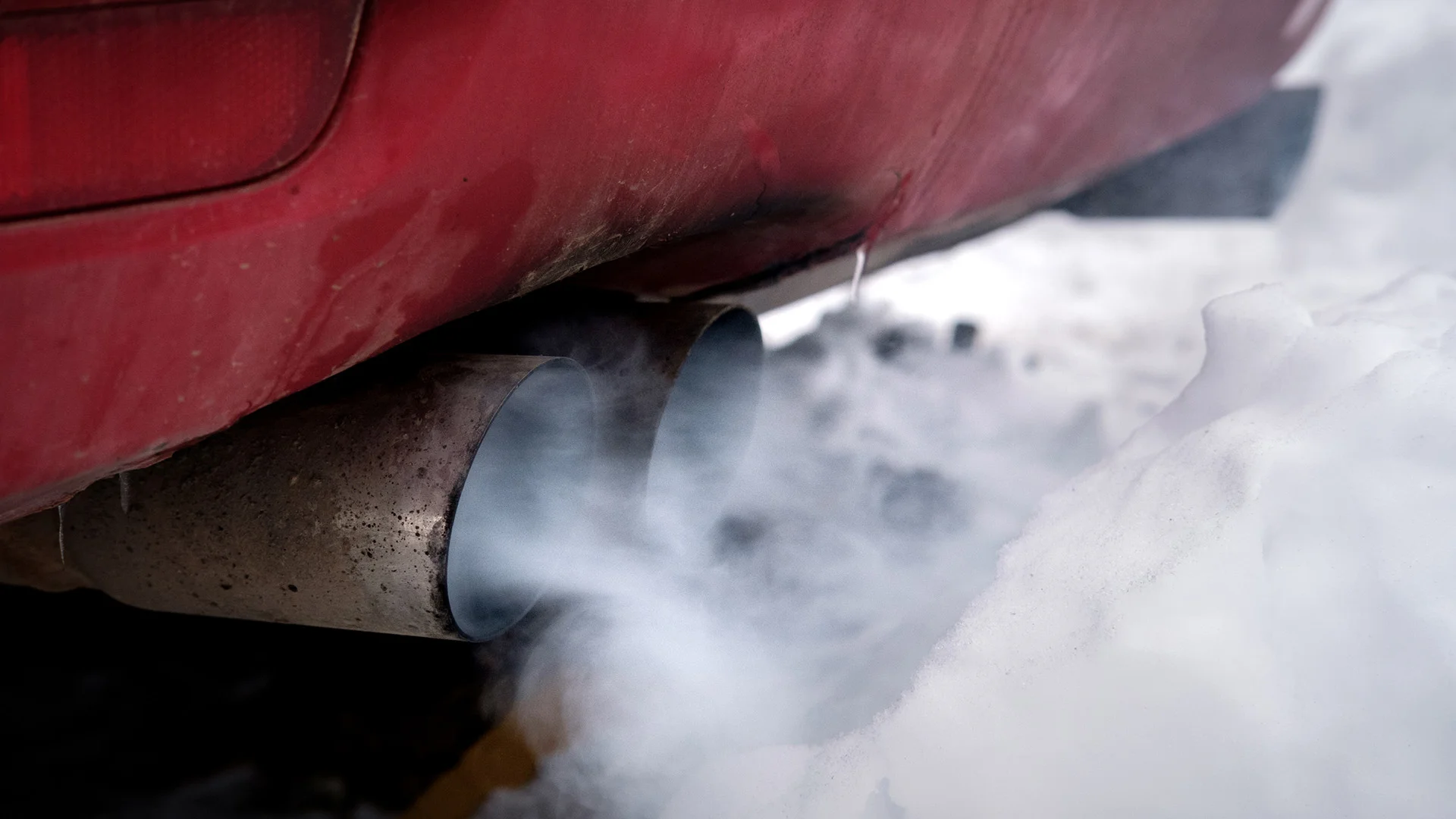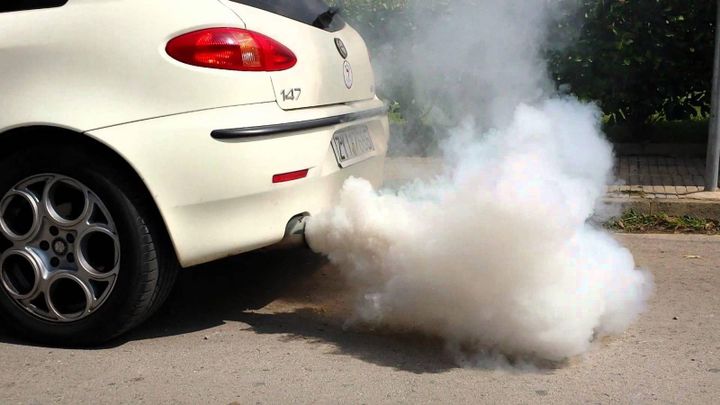


White smoke from the exhaust on startup is a common issue that many vehicle owners encounter. This phenomenon occurs when unburned fuel condenses in the exhaust system, creating a white vapor that is visible upon starting the engine. While it may seem alarming, this issue is generally not a major concern if the smoke dissipates quickly after the engine warms up. However, persistent white smoke can indicate underlying problems that require attention.

One of the most prevalent causes of white smoke from the exhaust on startup is condensation buildup within the exhaust system. When an engine is cold, water vapor present in the exhaust condenses and forms white smoke as it exits the tailpipe. This is a perfectly normal occurrence, especially in colder weather conditions.
Imagine waking up on a chilly morning and stepping outside to start your car. As the engine cranks to life, you may notice a puff of white smoke emerging from the exhaust. This is simply the condensed water vapor being expelled as the exhaust system begins to warm up. Within a minute or two, the smoke should dissipate, and your exhaust should return to its usual clear state.
While condensation is the most common cause, there are a few other potential issues that can lead to white smoke from the exhaust on startup. Let's explore these in detail:
| Cause | Description |
|---|---|
| Coolant Leaks | A cracked cylinder head, blown head gasket, or cracked engine block can allow coolant to leak into the combustion chamber. When this coolant is burned, it produces white smoke from the exhaust. This is a serious issue that requires immediate attention, as it can lead to further engine damage if left unaddressed. |
| Faulty Fuel Injectors | Stuck open or leaking fuel injectors can cause too much fuel to enter the combustion chamber, resulting in unburnt fuel exiting as white smoke. This issue can also lead to poor fuel economy and decreased engine performance. |
| Intake Manifold Gasket Leak | A leaking intake manifold gasket can allow coolant to seep into the cylinders and produce white smoke from the exhaust. This issue is often accompanied by a coolant smell and potential engine overheating. |
A coolant leak is one of the most serious causes of white smoke from the exhaust on startup. When coolant leaks into the combustion chamber, it can lead to various issues, including:
Decreased engine performance
Increased fuel consumption
Potential engine damage
There are several reasons why coolant leaks can occur, including:
Cracked cylinder head
Blown head gasket
Cracked engine block
In these cases, the coolant is able to seep into the combustion chamber, where it is burned and expelled as white smoke from the exhaust.
Fuel injectors play a crucial role in delivering the correct amount of fuel to the engine's combustion chambers. When these injectors malfunction, it can lead to various issues, including white smoke from the exhaust on startup.
Stuck open injectors: If an injector becomes stuck in the open position, it will continuously spray fuel into the combustion chamber, even when the engine is not running. This excess fuel can then exit the exhaust as white smoke.
Leaking injectors: Leaking injectors can also cause too much fuel to enter the combustion chamber, resulting in unburnt fuel exiting as white smoke from the exhaust.
In addition to white smoke, faulty fuel injectors can also lead to poor fuel economy, rough idling, and decreased engine performance.
The intake manifold gasket plays a crucial role in sealing the intake manifold to the engine block, preventing coolant from entering the combustion chambers. When this gasket fails or develops a leak, coolant can seep into the cylinders and be burned, resulting in white smoke from the exhaust.
Intake manifold gasket leaks are often accompanied by other symptoms, such as:
Coolant smell from the exhaust
Engine overheating
Coolant loss without any visible leaks
If left unaddressed, an intake manifold gasket leak can lead to further engine damage and potentially costly repairs.
As a mechanic, I follow a systematic approach to diagnose the root cause of white smoke from the exhaust on startup. Here are the steps I typically take:
Observe the Smoke Pattern: I pay close attention to when the smoke occurs (on startup, while driving, etc.) and how long it lasts. Condensation smoke should dissipate within a minute or two, while smoke from other issues may persist or worsen.
Check Coolant Level and Condition: Low coolant level, coolant contamination, or a sweet odor from the exhaust can indicate a coolant leak, which is a potential cause of white smoke.
Use a Block Tester Kit: This specialized kit allows me to check for the presence of exhaust gases in the coolant system, which confirms a head gasket or cylinder head/block issue.
Look for Bubbles in the Coolant Reservoir: If I notice bubbles in the coolant reservoir while the engine is running, it's another sign of a head gasket leak.
Inspect Fuel Injectors: In cases where a faulty fuel injector is suspected, I may perform a visual inspection or use specialized diagnostic tools to check for stuck open or leaking injectors.
Check Intake Manifold Gasket: If an intake manifold gasket leak is suspected, I will inspect the gasket for signs of damage or deterioration and check for coolant leaks around the manifold area.
Once the root cause has been identified, it's time to address the issue. Here are the typical repair instructions and preventive measures:
If the white smoke is simply due to condensation, no repair is needed. It's a normal occurrence, and driving longer distances helps prevent buildup. However, if the smoke persists or worsens, further investigation is required.
Intake Manifold Gasket Replacement: If the issue is a leaking intake manifold gasket, the gasket needs to be replaced to prevent coolant from seeping into the cylinders.
Cylinder Head or Engine Block Repair/Replacement: In cases of cracks in the cylinder head or engine block, these components may need to be repaired or replaced to stop the coolant leak.
Head Gasket Replacement: A blown head gasket often requires partial engine disassembly to replace the gasket, which can be a labor-intensive and costly repair.
If the white smoke is caused by faulty fuel injectors, the injectors may need to be cleaned or replaced to restore proper fuel delivery and combustion.
To minimize the risk of white smoke from the exhaust on startup and potential engine damage, I recommend the following preventive measures:

Regular Coolant System Inspection and Maintenance: Periodic checks and maintenance of the coolant system can help identify and address potential issues before they escalate.
Use Recommended Coolant Type and Change Intervals: Using the correct coolant type and adhering to the recommended change intervals can help prevent coolant system issues.
Avoid Overheating the Engine: Overheating can lead to coolant leaks and other engine problems, so it's essential to address any overheating issues promptly.
Use Proper Octane Fuel for Your Vehicle: Using the recommended octane fuel for your vehicle can help prevent issues with fuel delivery and combustion.
Regular Fuel System Maintenance: Keeping the fuel system clean and well-maintained can help prevent issues with fuel injectors and other components.
The cost of repairs related to white smoke from the exhaust on startup can vary significantly depending on the issue and the extent of the repair required. Here's a general breakdown of potential costs:
| Repair | Cost Range |
|---|---|
| Intake Manifold Gasket Replacement | $100 - $400 |
| Fuel Injector Replacement | $800 - $1,500 |
| Head Gasket Replacement | $1,000 - $2,000 |
| Cylinder Head Replacement | $1,500 - $3,500 |
| Engine Block Repair/Replacement | $3,000 - $7,000+ |
It's important to note that these costs can vary based on the vehicle make, model, and labor rates in your area. For major repairs, I always recommend getting multiple quotes to ensure you're getting a fair price.
White smoke from the exhaust on startup can be a concerning sight for car owners, but in many cases, it's a harmless byproduct of condensation. However, it's crucial to be vigilant and address any persistent or worsening smoke, as it could indicate more serious issues like coolant leaks or faulty fuel injectors.
As a mechanic, my role is to thoroughly diagnose the root cause and provide effective repair solutions while also emphasizing preventive measures to maintain your vehicle's health. By following the diagnostic steps, repair instructions, and preventive measures outlined in this article, you can better understand and address white smoke from the exhaust on startup, ensuring a smooth and reliable driving experience.
Remember, regular maintenance and addressing issues promptly can save you from costly repairs down the line. So, if you ever encounter white smoke from your exhaust on startup, don't hesitate to seek professional assistance. Your trusty mechanic will be there to guide you through the process and keep your vehicle running smoothly.
White smoke indicates the presence of water vapor or coolant in the exhaust, while blue smoke signifies burning oil, and black or gray smoke points to unburned fuel.
No, a clogged air filter is unlikely to cause white smoke from the exhaust, as it primarily affects the air intake rather than the combustion process.
Driving longer distances and avoiding short trips can help prevent excessive condensation buildup in the exhaust system.
Yes, a stuck-open thermostat can cause the engine to run cooler than normal, leading to increased condensation and potential white smoke from the exhaust.
White smoke is more commonly seen in older vehicles due to wear and tear on components like gaskets and seals, but it can occur in newer vehicles as well.
Yes, a cracked exhaust manifold can allow coolant to leak into the exhaust system, resulting in white smoke.
If the white smoke is present immediately upon startup and dissipates quickly, it's likely from the exhaust system. If it persists or worsens, it may be an engine issue.
No, a faulty oxygen sensor is unlikely to directly cause white smoke from the exhaust, but it can be a symptom of other issues that may lead to white smoke.
It's generally not recommended to drive with persistent white smoke, as it can indicate a serious issue that may lead to further damage if not addressed promptly.
It's recommended to have your coolant system inspected at least once a year or as per the manufacturer's maintenance schedule to catch any potential issues early.

Sarah isn't your average gearhead. With a double major in Mechanical Engineering and Automotive Technology, she dived straight into the world of car repair. After 15 years of turning wrenches at dealerships and independent shops, Sarah joined MICDOT to share her expertise and passion for making cars run like new. Her in-depth knowledge and knack for explaining complex issues in simple terms make her a valuable asset to our team.












